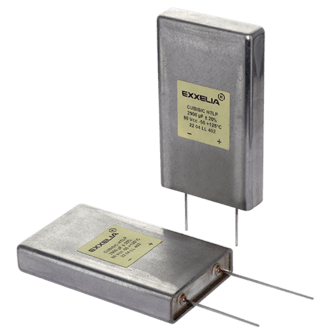Radial Aluminum Electrolytic Capacitors CUBISIC HTLP

Main Features
- Up to 60% more capacitance than any other rectangular capacitor on the market
- Designed to offer excellent performance at high temperatures (55°C to +125°C)
- Super Low Profile, super thin
- Highest Energy Density
- Longest Lifetime of its category
- Up to 20G Vibrations
- Low pressure @92,000 feet
- Exists with high energy density with CUBISIC SLP
Typical Applications
- Filtering
- Energy storage
- Hermetic case with laser welding
- Low profile printed circuit mounting
- Possible mounting with 45 x 12 bracket (A691057)
- Possible thermal dissipation per conduction through lower and upper surface
Technical Characteristics
Dielectric
- Aluminum
Capacitance
- Minimum : 140 µF
- Maximum : 58000 µF
Voltage DC
- Minimum : 7,5 V
- Maximum : 350 V
Voltage AC
- Not supported
Temperature
- Minimum : -55 °C
- Maximum : 125 °C
Case sizes
- 45x13x38 45x13x51 45x13x76
Terminations
- leads
Notes
- Custom versions on request
Related Standards
DIN
41 240IEC
60 384-4CECC
30301Related Documents
Technical Papers
3D Models
- No Model
Frequently Asked Questions
Aluminum Electrolytic
Q: Searching for a product with Large Capacitance?
Aluminum electrolytic capacitors, also commonly known as just electrolytic capacitors, are a unique type of configuration that uses an electrolyte to achieve a capacitance that is much larger than other types of these devices. The electrolyte in question is usually either a gel or a liquid that itself contains a very high concentration of polarized ions. Polarization indicates that the voltage on the positive terminal is always larger than the similar voltage on the negative terminal of the capacitor.
One of the major benefits of these types of aluminum electrolytic capacitors is the aforementioned large capacitance. They do, however, have a number of disadvantages when compared to other types of capacitors. Aluminum electrolytic capacitors have a large leakage current when compared to capacitors of other types. Additional disadvantages include a limited lifetime, value tolerances and an equivalent resistance series.
Q: Why are Electrolyte Capacitors Forward Biased?
For safety purposes, these types of capacitors need to be forward biased in their configuration. This is mainly due to the characteristics of the electrolyte that has been used in their construction. The positive terminal always needs to have a larger amount of voltage than that of the negative terminal. If the situation were reversed and the negative terminal suddenly had a higher voltage than the positive terminal (which is also referred to as reversing the voltage polarity), the aluminum material that is used as the dielectric could short circuit and become damaged. It could also overheat, which could cause a substantial leak. The capacitor could also vaporize, which could cause the entire enclosure to burst under the right circumstances. It is important to note, however, that this phenomenon is very rare.